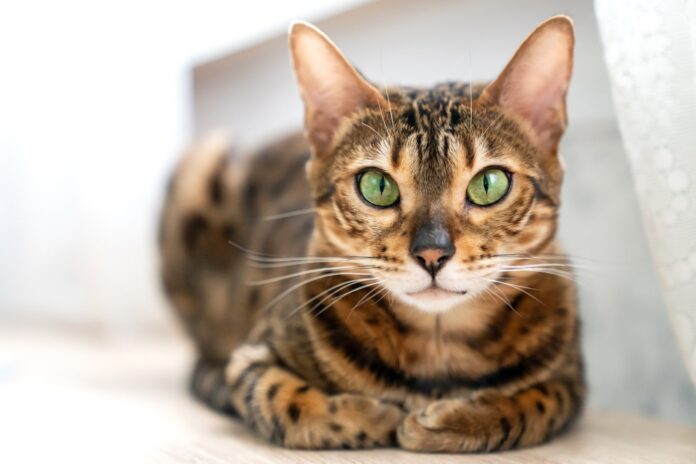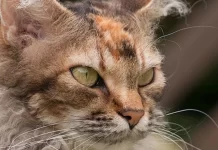Last Updated on September 3, 2023 by Fumipets
Bengal Cats: Grace, Beauty, and Wild Elegance
Bengal Cats invites us into the captivating world of these exquisite feline companions. With their distinctive marbled or spotted coats reminiscent of their wild ancestors, Bengal cats exude an air of elegance and adventure.
This summary explores the unique characteristics, history, and joys of sharing your home with a Bengal cat, a breed known for its intelligence, playfulness, and striking appearance.
Bengal Cats
When a Bengal cat first enters your home, you might mistakenly believe a wild cat has sneaked in. This is due to the extraordinary breed’s speckled or mottled hair, which closely resembles an ocelot or a leopard in the wild. However, the Bengal has a caring, affable demeanor and is anything but an untamed animal. Bengals were created by mating tame cats with an Asian leopard cat, but their feral natures have been long suppressed.
Bengal cats were approved as a species for the first time in 1983, and since then, their appeal has soared. Bengal cats are divided into different categories based on how many years have passed since their initial feral progenitor, just like some other mix varieties like the Savannah cat. An F1 is the name given to the juvenile of the Asian cat. Additionally, each succeeding iteration is given a number suffix, such as F2, F3, F4, etc. A Bengal cat needs to be at least an F4 to qualify as a true household cat.
Check with your state and municipal agencies before purchasing a Bengal cat or pup; in some places, such as Hawaii and New York City, they are prohibited. If they are from the F1–F3 series, Bengals may also be subject to limitations.
Appearance
Bengal cats typically measure between 8 and 15 pounds and are a lean and nimble species. They are valued for having thick, short coats with striking patterns in various tones of brown, silver, and white. Their pelt feels somewhat like rabbit hair and is extremely delicate to the touch. Bengal cats typically have eyes that are brown, golden, orange, or green.
The Bengal cat’s distinctive pelt distinguishes him from other felines. The only type that can have rosette patterns that truly represent their untamed Asian leopard heritage is the Bengal. Coats with spots or marble patterns are equally stunning and fashionable. They only need to be brushed once a week to get rid of stray hair and dead skin cells because their fur is so brief.
Bengal cats have similar weights to domestic cats, but due to their lengthy, powerful frames, they tend to be bigger in size. You shouldn’t be shocked if you see your Bengal gazing down at you from bookcases and tables because they have long legs that make them superb climbers.

Temperament
Bengals are gentle and lovely on the inside, despite their untamed exterior. These friendly cats are sociable, but they might declare one member of the household as their favorite. Bengal cats get along well with young toddlers, other cats, and household canines. The secret, though, is early interaction and introduction to family members. You may face difficulties if you attempt to bring a new companion to elder Bengals who are already accustomed to their habits.
Bengals require continuous stimulus to keep their large minds active because they are a clever and inquisitive species. They appreciate interacting with objects and are known to enjoy a small pool and the water. Bengals can be trained to perform tasks and even learn how to travel on a lead for excursions outside.
Additionally, Bengal cats have a reputation for chatting up their caretakers. They don’t meow a lot, but when they do, it’s usually to say something like, “My food bowl is almost empty,” or “I want to play.” When you return home from a hard day at work, a Bengal won’t just stand around doing nothing. A song and a regal salute are to be expected.
Living Needs
Bengal cats love being close to their owners. As long as you and your family are close by, he doesn’t care where he lives—big home or tiny flat. Nevertheless, a Bengal requires a lot of things to do—and climb—regardless of the extent of your room.
For this large cat, owners should have at least one cat tree and a ton of toys to keep him occupied while you’re gone. Additionally, keeping your cat entertained and occupied is easier if you have a second cat if you spend a lot of time away from home.
Bengal cats appreciate observing birds, rodents, and other creatures from the safety of your house and have a strong predation drive. It’s a fantastic idea to put a cushioned platform (or two) to give him a comfy watching location because he loves to talk at the window.
Just remember to keep breakables off of shelves and mantels that your Bengal can access. Because of this breed’s exceptional agility, it is unavoidable that your cat will ultimately investigate every elevated place he can access. Therefore, safeguard your Faberge egg collection somewhere where your cat can’t tip it over if you’re pleased with it. Installing kitty racks in your house could also aid in preventing him from touching your breakables!
And after a long day of pursuing plastic mice, Bengals will snuggle up on your chest for a nice nap even though they aren’t generally thought of as sofa dogs.
Care
A Bengal cat must be mentally active to be content. Introduce your cat to other people, kids, pets, the vehicle, and even a lead and collar for outings when they are young. Bengals profit from a variety of situations because they are so clever, so involve them early and frequently. To prevent your cat from becoming tired, it also helps to provide a lot of cat games and switch them out on a regular basis.
A Bengal’s hair requires little maintenance; all that is required to keep it looking its best is a weekly brushing. And given how much they adore the water, taking a wash on occasion might be something they eagerly anticipate. As with any type of cat, regular dental and foot maintenance is crucial.

Health
The average longevity of a Bengal cat is 9 to 15 years, and they are a generally robust species. But before you buy a new cat, as with all cats, you should be aware of a few health concerns. The majority of conscientious breeders take great care to avoid breeding animals with hereditary health issues, but three of the most prevalent ailments among Bengals are:
Heart disease: Hypertrophic cardiomyopathy, a cardiac condition that is more common in elderly Bengal cats, can result in the heart muscle thickening. This can shorten longevity and cause blood blockages or chronic heart failure.
Eye disease: Bengals are susceptible to the eye illness known as progressive retinal atrophy, which can lead to retinal degeneration and eventually blindness.
Anesthetic allergies: Bengals should be closely monitored during any procedures, including cutting and spaying, as they can be highly sensitive to anesthetics. Cardiac failure can happen as a consequence of an adverse response to anesthetics.
History
Although domestic cats and Asian leopard cats were crossed as early as the 1800s, it wasn’t until the middle of the 20th century that the species began to flourish. According to the Cat Fanciers’ Association, breeder and environmentalist Jean Mill made the first domestic cat hybrid with an Asian leopard cat in 1963. Bengals were affiliated with the CFA by 1996. Animals from the F6 group or later are considered acceptable.
Of course, it comes as no wonder that they have rapidly surpassed cats that have been around for centuries as one of the most famous varieties in the world given their loving, clever dispositions and eye-popping hair hues and designs.
Questions & Answers:
What makes Bengal cats stand out in terms of appearance?
Bengal cats are known for their striking coat patterns, which often feature rosettes or marbling that resemble those of wild leopards or ocelots. Their distinctive appearance sets them apart from other domestic breeds.
Are Bengal cats known for their wild ancestry, and do they have unique behavior traits?
Yes, Bengal cats have a wild lineage, with Asian leopard cat ancestry. This heritage can influence their behavior, making them more active, playful, and curious than some other domestic breeds.
What is the temperament of Bengal cats, and how do they interact with their owners?
Bengal cats are often described as intelligent, energetic, and affectionate. They form strong bonds with their owners and enjoy interactive play and mental stimulation. They can be vocal and express their needs clearly.
How do you care for the special needs of Bengal cats, given their active nature?
Providing ample opportunities for exercise and mental stimulation is essential for Bengal cats. Interactive toys, climbing structures, and engaging playtime can help satisfy their energetic nature.
Do Bengal cats require any specific grooming or healthcare considerations?
Bengal cats have short, dense coats that are relatively low-maintenance. Regular brushing can help reduce shedding and keep their coat healthy. Like all cats, they should receive routine veterinary care to maintain their overall health and well-being.


















